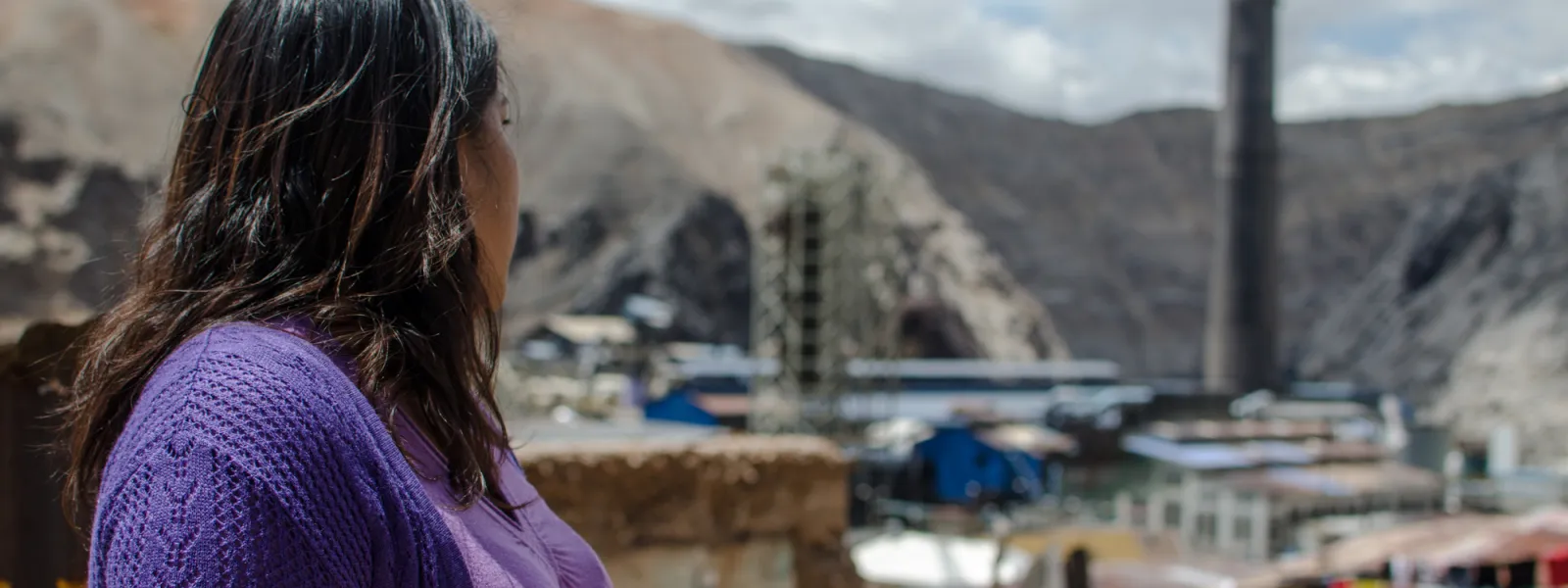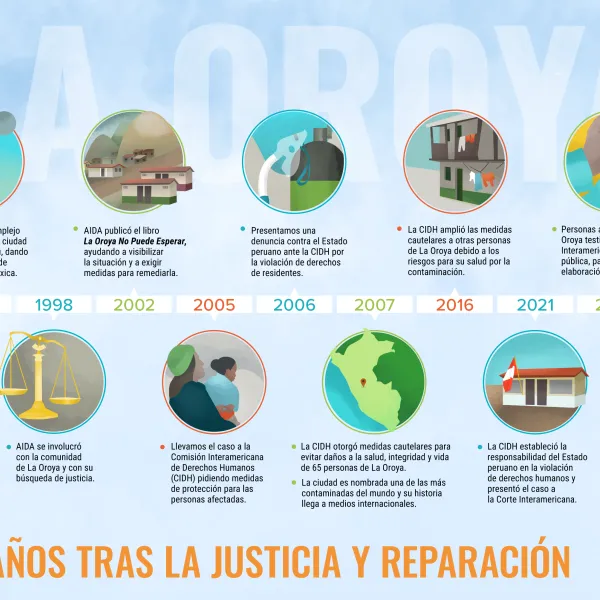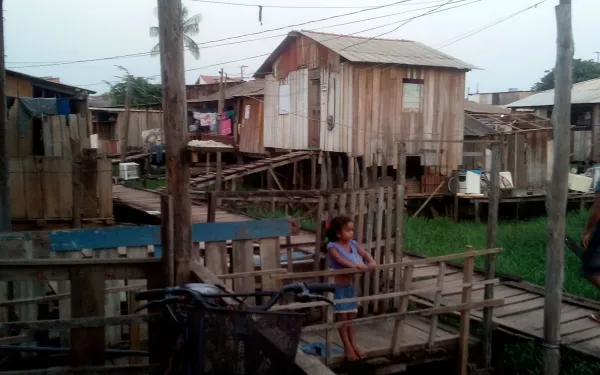
Project
Protecting the health of La Oroya's residents from toxic pollution
For more than 20 years, residents of La Oroya have been seeking justice and reparations after a metallurgical complex caused heavy metal pollution in their community—in violation of their fundamental rights—and the government failed to take adequate measures to protect them.
On March 22, 2024, the Inter-American Court of Human Rights issued its judgment in the case. It found Peru responsible and ordered it to adopt comprehensive reparation measures. This decision is a historic opportunity to restore the rights of the victims, as well as an important precedent for the protection of the right to a healthy environment in Latin America and for adequate state oversight of corporate activities.
Background
La Oroya is a small city in Peru’s central mountain range, in the department of Junín, about 176 km from Lima. It has a population of around 30,000 inhabitants.
There, in 1922, the U.S. company Cerro de Pasco Cooper Corporation installed the La Oroya Metallurgical Complex to process ore concentrates with high levels of lead, copper, zinc, silver and gold, as well as other contaminants such as sulfur, cadmium and arsenic.
The complex was nationalized in 1974 and operated by the State until 1997, when it was acquired by the US Doe Run Company through its subsidiary Doe Run Peru. In 2009, due to the company's financial crisis, the complex's operations were suspended.
Decades of damage to public health
The Peruvian State - due to the lack of adequate control systems, constant supervision, imposition of sanctions and adoption of immediate actions - has allowed the metallurgical complex to generate very high levels of contamination for decades that have seriously affected the health of residents of La Oroya for generations.
Those living in La Oroya have a higher risk or propensity to develop cancer due to historical exposure to heavy metals. While the health effects of toxic contamination are not immediately noticeable, they may be irreversible or become evident over the long term, affecting the population at various levels. Moreover, the impacts have been differentiated —and even more severe— among children, women and the elderly.
Most of the affected people presented lead levels higher than those recommended by the World Health Organization and, in some cases, higher levels of arsenic and cadmium; in addition to stress, anxiety, skin disorders, gastric problems, chronic headaches and respiratory or cardiac problems, among others.
The search for justice
Over time, several actions were brought at the national and international levels to obtain oversight of the metallurgical complex and its impacts, as well as to obtain redress for the violation of the rights of affected people.
AIDA became involved with La Oroya in 1997 and, since then, we’ve employed various strategies to protect public health, the environment and the rights of its inhabitants.
In 2002, our publication La Oroya Cannot Wait helped to make La Oroya's situation visible internationally and demand remedial measures.
That same year, a group of residents of La Oroya filed an enforcement action against the Ministry of Health and the General Directorate of Environmental Health to protect their rights and those of the rest of the population.
In 2006, they obtained a partially favorable decision from the Constitutional Court that ordered protective measures. However, after more than 14 years, no measures were taken to implement the ruling and the highest court did not take action to enforce it.
Given the lack of effective responses at the national level, AIDA —together with an international coalition of organizations— took the case to the Inter-American Commission on Human Rights (IACHR) and in November 2005 requested measures to protect the right to life, personal integrity and health of the people affected. In 2006, we filed a complaint with the IACHR against the Peruvian State for the violation of the human rights of La Oroya residents.
In 2007, in response to the petition, the IACHR granted protection measures to 65 people from La Oroya and in 2016 extended them to another 15.
Current Situation
To date, the protection measures granted by the IACHR are still in effect. Although the State has issued some decisions to somewhat control the company and the levels of contamination in the area, these have not been effective in protecting the rights of the population or in urgently implementing the necessary actions in La Oroya.
Although the levels of lead and other heavy metals in the blood have decreased since the suspension of operations at the complex, this does not imply that the effects of the contamination have disappeared because the metals remain in other parts of the body and their impacts can appear over the years. The State has not carried out a comprehensive diagnosis and follow-up of the people who were highly exposed to heavy metals at La Oroya. There is also a lack of an epidemiological and blood study on children to show the current state of contamination of the population and its comparison with the studies carried out between 1999 and 2005.
The case before the Inter-American Court
As for the international complaint, in October 2021 —15 years after the process began— the IACHR adopted a decision on the merits of the case and submitted it to the Inter-American Court of Human Rights, after establishing the international responsibility of the Peruvian State in the violation of human rights of residents of La Oroya.
The Court heard the case at a public hearing in October 2022. More than a year later, on March 22, 2024, the international court issued its judgment. In its ruling, the first of its kind, it held Peru responsible for violating the rights of the residents of La Oroya and ordered the government to adopt comprehensive reparation measures, including environmental remediation, reduction and mitigation of polluting emissions, air quality monitoring, free and specialized medical care, compensation, and a resettlement plan for the affected people.
Partners:

Related projects
Belo Monte Dam controversy to be part of UN’s Review of Brazil’s Human Rights Record
Geneva, Switzerland. On May 25, the United Nations will examine the Brazilian government’s track record for human rights during its Universal Periodic Review (UPR) in Geneva, Switzerland. Central to this debate will be the multiple claims of human rights violations surrounding the construction of the Belo Monte Hydroelectric dam, slated for the Xingu River in Brazil. Many Brazilian and international groups have already sent extensive documentation to the UN highlighting the human rights violations suffered by the indigenous and rural communities in the dam’s path. The UN High Commissioner for Human Rights will present information from these and other reports as part of the review or the Brazilian government’s performance on its human rights obligations. Key to the controversy over the dam will be the lack of compliance with an April 2011 resolution from the Inter-American Commission on Human Rights (IACHR), an international human rights body of the Organization of American States. The Commission requested that the government halt the project and take steps to protect indigenous communities, including un-contacted tribes in voluntary isolation. Up until now, the Brazilian government has refused to either implement the IACHR’s resolution or dialogue with affected communities in the case. Two civil society reports sent by a coalition of Brazilian and international groups last November highlighted these and other problems with Brazil’s contentious hydroelectric project. The report concludes that the government did not consult with affected communities nor obtain their free, prior, and informed consent, as required by international human rights law. It also documents violations to the rights to life and health, and the possible forced displacement of nearly 40 thousand families. The two reports form part of a growing body of allegations regarding human rights violations related to the Brazilian government’s plans to push the construction of large dams in the Amazon region. “We hope that as a result of the UPR, the Brazilian government will take a hard look at the damage that its energy and hydropower policies are causing for the rights of indigenous and traditional peoples,” stated Astrid Puentes, Co-director of the Interamerican Association for Environmental Defense (AIDA), which co-authored the reports. “Brazil has a great opportunity to change its development model toward one that is truly sustainable and respects human rights.” According to Andressa Caldas, Director of the Brazilian human rights NGO, Global Justice, Belo Monte is now synonymous with violations of indigenous peoples’ rights and environmental irresponsibility. “The Brazilian government will have to respond to these allegations and is already expanding its delegation for the UPR with experts specifically to defend the Belo Monte dam. But there is no way to justify such an absurd project.” What is the UPR? The Universal Periodic Review is a proceeding in which all UN nations are reviewed every four years by the UN Human Rights Council, which is made up of representatives from different countries. During the process each country is given the opportunity to demonstrate the steps it has taken to improve the human rights situation and meet its obligations under international law.
Read morePrior consultation: An opportunity for life, respect and diversity
By Héctor Herrera, legal advisor, AIDA, @RJAColombia Colombia’s ethnic groups have decrees and laws that protect their cultural persity, that defend the individual and collective livelihood of these native and traditional peoples and communities. Article 6 of Convention No. 169 of the International Labour Organization (ILO) stipulates that indigenous peoples have the right to prior consultation. That means that they should participate in defining the measures that could have a direct impact on them, whether legislative (such as laws or decrees) or administrative (environmental permits for highways, dams, mines, oil wells, and the like). The negotiations should be carried out in good faith and with the goal of reaching agreements on all sides. This has become very important in Colombia, a multiethnic, multicultural, and diverse country. According to the Luis Ángel Arango Library, 65 indigenous languages in 12 language families are spoken in Colombia, of which 34 have less than one thousand speakers. Traditional Afro groups speak two different Creole languages. Yet all of these languages are in danger. Colombia also is extremely diverse in biological species globally, ranking first in birds, second in amphibians and butterflies, third in reptiles, and fourth in mammals, according to the Humboldt Institute. Colombian newspaper El Espectador reported 2011 data showing that 10% of all biodiversity is found on 1% of the planet’s surface. In Columbia, 29.8% of this is collective indigenous territory and 5% is collective traditional Afro territory. Understanding this, prior consultation emerges as an opportunity to protect the cultural and ethnic persity of Colombia and defend the inpidual and collective livelihood of the many native and traditional peoples and communities. It is, too, an opportunity to protect the ecosystems that these ethnic groups inhabit as well as to protect life in all its forms. This does not mean forcing anybody to adopt a conservation, extractive, or development model. It simply means making sure that an effective space is provided for clear, honest, and intercultural dialogue with ethnic groups on measures that could affect them, whether legislative or administrative measures or national laws or extractive mining projects. This is completely in line with the stipulations of Article 6 of Convention No. 169 of the ILO . This right has also been recognized in numerous national and international legal documents. On the international level, we have the United Nations Declaration on the Rights of Indigenous Peoples, adopted in 2007 (PDF file). In Colombia, we have the Political Constitution, which protects the rights of ethnic groups to their collective territory and the rights of all of society to a healthy environment. With the backing of international legal documents and the Political Constitution, the Constitutional Court of Colombia upheld the right to prior consultation for the “Embera indigenous people” in relation to the construction of the Urrá dam in 1998 and for Amazon indigenous peoples on the fumigation of illegal crops in 2003. In other cases, the High Court declared unconstitutional the National Development Plan of 2006-2010, the forestry law of 2006 and the mining code reform of 2010 because the proponents had not consulted with ethnic groups. There are yet more cases outside Colombia, such as Bolivia with the Multinational Constitution of 2009 and Ecuador with the Intercultural and Multinational Constitution of 1998, both of which recognize the right to prior consultation. So too Peru, where a law on this right was just passed this year. Culture, language and a view of the world – all of these can live on through time if we respect them and guarantee people’s rights, including the right to prior consultation. The protection of this right could also contribute to the protection of important ecosystems and of biological persity, both of which are vital issues as we face unprecedented climate change and environmental degradation.
Read more
Brazilian Government questioned yet again by international human rights body over Belo Monte Dam controversy
Brasilia, Brazil - On April 11, the Inter-American Commission on Human Rights (IACHR), the human rights arm of the Organization of American States (OAS), asked the Brazilian government to explain reports of poor water quality and forced evictions in indigenous communities affected by the construction of the Belo Monte Hydroelectric Dam in the Xingu River Basin, Brazil. This is the second time that the Inter-American Commission has asked the government to explain the health and human rights impact of construction since requesting precautionary measures in favor of indigenous communities in April of last year. The IACHR also repeated its request that Brazil detail specific measures designed to mitigate the dam’s impact. The commission gave Brazil 20 days to respond regarding the situation in the Xingu River Basin. “We hope the Brazilian government will react quickly to this latest resolution by taking steps to protect the human rights of affected communities,” said Jacob Kopas, legal counsel with the Interamerican Association for Environmental Defense (AIDA). The IACHR is currently reviewing an international lawsuit filed by the Xingu River Alive Forever Movement (MXVPS), Para Society for the Defense of Human Rights (SDDH), Global Justice, and AIDA. The lawsuit highlights the damages the project is causing to the Paquiçamba and Arara da Volta Grande Indigenous Reservations. “The case before the IACHR aims for Brazil to meet its obligations under international human rights treaties,” explained Roberta Amanajás, lawyer with SDDH. “And in the Belo Monte case, there is abundant evidence these rights are being violated.” This past January, indigenous communities downstream of the construction site registered several cases of diarrhea and skin rashes associated with the sudden deterioration in the water quality of the river, on which they depend for drinking, bathing and cooking. In response, the Brazilian Federal Public Ministry conducted an independent water quality analysis but results have not been published yet. According to Public Ministry officials, constant water control tests are necessary to avoid the risk of contaminating the river’s waters. Another complaint under investigation by the IACHR concerns the forced eviction of impoverished, rural communities, in an area where most small farmers do not have formal deeds to their land. Fearing evictions without any compensation whatsoever, many families have accepted payments worth less than half the market value of their lands. This was the case of farmers from the Santo Antonio village, where only 26 out of 252 rural properties had a formal deed. In one case, a farmer received only $3,775 USD for a property that would have fetched almost $12,000 USD on the open market a few years ago.
Read more